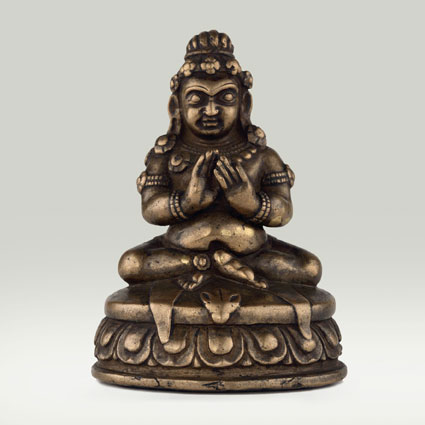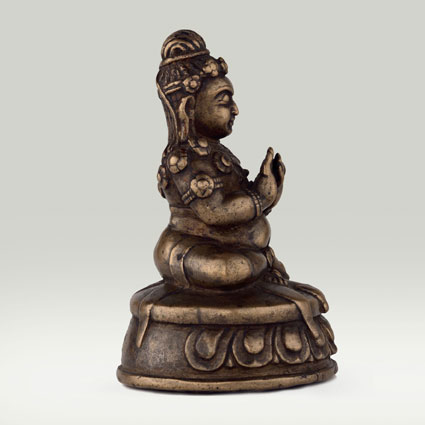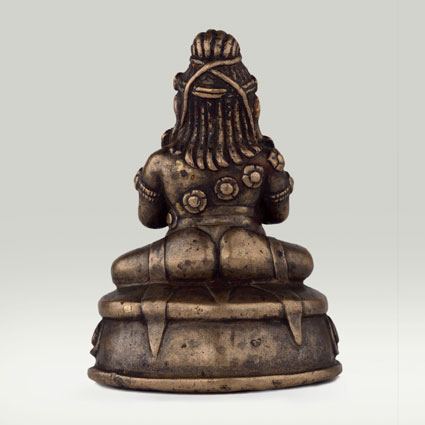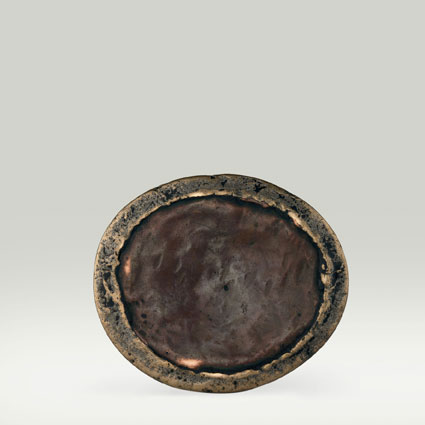ABS 096
Code: ABS 096
Country: Tibet
Style:
Date: 1500 - 1600
Dimensions in cm WxHxD: 5.9 x 8.3 x 5.1
Materials: Brass
The bottom of the pedestal is sealed with a copper plate decorated flower emblems.
The Mahasiddha Virupa (Tib. Grub chen Bir wa pa), identified as such by the flower garland, is seated in the diamond attitude (vajraparyankasana) on a animal hide placed upon a single lotus pedestal. He displays with the hands the “gesture of setting in motion the Wheel of Law” (dharmacakra-pravartana-mudra).
Virupa is more often shown in the attitude of royal ease (rajalilasana) and holds in the right hand a skull-cup (kapala) while the left hand displays the gesture of threatening (tarjani-mudra).
Mahasiddha Virupa, who was born in India and lived during the first half of the 9th century, was in Tibet especially popular with the Sa skya tradition. It is recorded that Virupa (Tib. Bir wa pa) received the instructions of thelam ’bras doctrine from the dakini Nairatmya (Tib. bDag med ma) and transmitted it to Krsnacariya, also known as Kanhapa (Tib. Nag po pa). Two Mahasiddhas of the name Virupa are known, being teacher and disciple.
Mahasiddha Virupa
Virupa was born as the crown prince into a royal family in south of India, some 1020 years after Lord Buddha reached nirvana or enlightenment. However, the dating of Virupa is somewhat uncertain given the limited factual evidence although it is believed that Virupa made at least three appearances in this world.
At a young child, Virupa received the novice ordination in the famous monastery of Somapura in North Bengal. After completion of his studies there, he left for the Nalanda Monastery where he received the bhikhu ordination from, Dharmamitra, the Abbot of Nalanda, where he was given the name Dharmapala. Virupa was known as Dharmapala and it was only towards the latter part of his life, after achieving Siddhi where he called himself, Virupa, which means "wicked".
At Nalandra, Dharmamitra gave Virupa Vajrayana teachings and in particular Chakrasamvara tantra. Virupa became the Abbot of Nalanda after the death of Dharmamitra. In the daytime, he gave teachings and composition and at night he secretly practiced Chakrasamvara.
At the age of 70, after many years of faithful practice on Vajrayana, Virupa began having dreams which he interpreted as bad omens and he saw no signs of spiritual attainment. Having decided that he had no karmic connection with Vajrayana, he threw his prayers beads into the latrine and gave up his practice on Vajrayana.
On the same night, the Goddess Nairatmya appeared in his dream and told him that he should not act in such a manner when he was about to attain the Siddhi. Hence, he was requested to pick up his beads and wash them in scented water and to continue his regular practice. The following evening, Vajra Nairatmya appeared before him in her own mandala of fifteen goddesses where she bestowed on Virupa the four initiations, after which Virupa attained the Path of Seeing of the First Bhumi. Virupa had then realised the true significance of his dreams which he wrongly interpreted as bad omens. From that evening onwards, Virupa attained a higher Bhumi each day until he became the great Bodhisattva of the Sixth Bhumi.
In order to express his gratitude to his Guru and Yidams, Virupa arranged for a Ganachakra feast offerings where meat and wine were included as offerings. The other monks began suspicious over such behaviour of their Abbot. Wishing to avoid any disparagement to the doctrine from the misunderstanding of his behaviour, Virupa declared himself "wicked" and left the Nalanda monastery. This was how the name Virupa came about.
Upon leaving Nalanda, Virupa headed for areas such as Varanasi, Bhimesara, and other south/east parts of India. In his journey, he met two men, Dombi Heruka (the boatman) and Krishnacharin, who became his two disciples. Virupa demonstrated his magical powers to many along the way, including kings and their spiritual advisers. Virupa was known for his magical power such as parting the water of the Ganges River on two occasions and halting the sun in its normal course for three days from a beer tavern in southern India. In Sowanatha, he built a temple and established a community of monks in Sowanatha and ordered that animal sacrifices be stopped thereby saving the lives of millions of animals.
When Virupa passed away, some said that he dissolved into a stone image and others said that he became a stone image. This stone image pointed at the sun with its right hand and held a container of gold paint in its left hand. It is said that this gold paint can turn any metal into gold.
Perhaps the great achievements of Virupa can be summed up with the eloquent words of His Eminence Chogye Trichen Rinpoche, who described the magical powers of Virupa and his dedication to Dharma as follows:
"In summary, just as no-one has paralleled the logician Dharmakirti's ability to uphold the teaching through skill in debate, nor King Ashoka's ability to uphold the teaching through power, Virupa's ability to uphold Dharma through magical powers is unequalled. In the Manjushri tantra it is said that the coming of powerful beings is prophesied by the letter Dhi. Although many take this prophesy to refer to the coming of the glorious Dharmakirti, those who follow Drokmi, the translator, say that it refers to the powerful yogin Virupa."
Dowman, Keith, 1985. Masters of Mahamudra: Songs and Histories of the Eighty-Four Buddhist Siddhas. New York: State University of New York. Pp. 43–52, no. 3: Virupa - Selected references to the iconography of Virupa
Grünwedel, Albert, 1916. “Die Geschichten der vierundachtzig Zauberer (Mahåsiddhas): Aus dem Tibetischen übersetzt”, [Caturaß¡ti-siddha-prav®tti by Abhayadatta; translated by sMon grub Shes rab into Tibetan as Grub thob brgyad cu rtsa bzhi’i lo rgyus], Baessler-Archiv. Band V. Leipzig: B. G. Teubner. Pp. 145–47, no. 3: Virupa - Selected references to the iconography of Virupa
Robinson, James B., 1979. Buddha’s Lions (RBL), the lives of the 84 Siddhas. Berkeley (Ca): Dharma Publishing. Pp. 27–32, no. 3: Virupa - Selected references to the iconography of Virupa
Schmid, Toni, 1958. The Eighty-Five Siddhas. Stockholm: The Sven Hedin Foundation; Statens Ethnografiska Museum. P. 36, no. 8: Bir va pa = Bi rupa - Selected references to the iconography of Virupa





